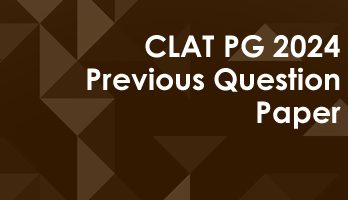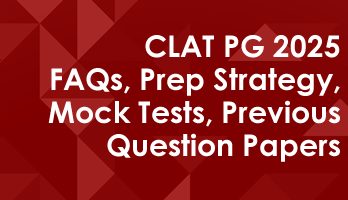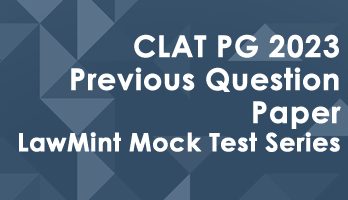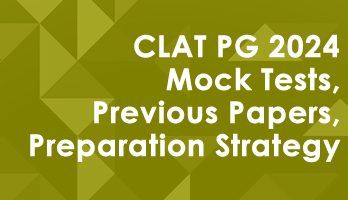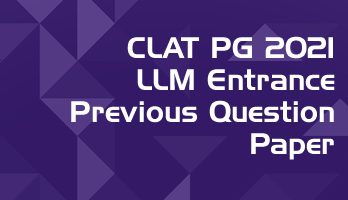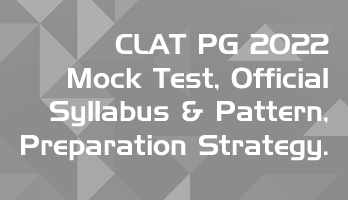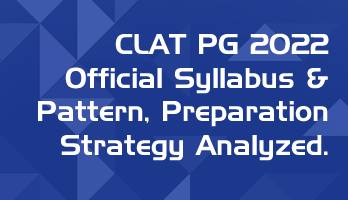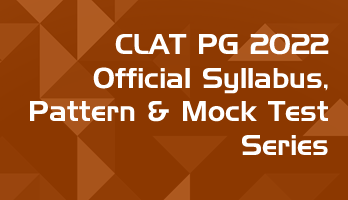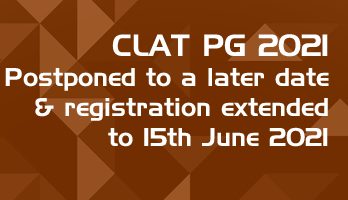This series of articles contains the complete CLAT PG 2020 question paper, conducted for the LLM admissions through the CLAT 2020 exam. In 2020, the pattern of the question paper was changed from the traditional MCQs to a ‘Comprehension based’ model. Each article in this series has one passage and the ten questions following it.
This article contains Passage 12 and the associated questions. The video embedded below discusses the answers as per the official key and the approach that can be used for such questions.
The answers to all the questions, for all the passages in the CLAT PG question paper are discussed in our YouTube video series at : https://www.youtube.com/lawmint
To make use of this question paper :
(1) The links to the complete series of articles is given below
(2) Read the passages and questions that follow
(3) Open our YouTube channel in another window or on your mobile phone (The video covering this specific passage is also embedded below.)
(4) Go through the series of videos where the answers to all the questions are discussed
The original plan by the CLAT Consortium was to have 10 passages, with 10 questions per passage and a subjective part. However, the subjective part was dropped and the number of passages was increased.
The CLAT PG 2020 exam had 12 passages, 120 questions – to be answered in 120 minutes. Click on the links below for the individual passages and the questions associated with the passage.
- Updated as per latest CLAT PG pattern
- Overall there are 300+ comprehension passages - with 2350+ questions
- 100 passages are provided as stand-alone mini mock tests
- 120 passages are combined to form 10 full-length mock tests
- 2020, 2021, 2022, 2023 and 2024 (New Pattern) Question papers included as mock tests
- Answers include the reason or 'rationale' for better understanding
- Order of the questions and answer choices are shuffled in every attempt for better practice
- The passages are of various lengths and complexities for better practice
- Unlimited access & practice - valid for one year from date of purchase
- Accessible 24 x 7 via Smart-Phone browsers and Desktops
- More the 100 LawMint users were selected by various top NLUs in 2020, 2021, 2022 and 2023 - Including NLSIU, NALSAR, NLU-J, WBNUJS
- Our users were also selected for the IIT KGP LLM, NLU Delhi (AILET PG) & DU LLM programs
Also included in the pack : (Useful for non-CLAT LLM entrance exams) :
- 11 CLAT PG old pattern previous Papers - 2009 to 2019 (as mock tests)
- 50 full-length old MCQ format mock tests (100 questions each)
- 50 old pattern MCQ mini-mock tests (25 questions each)
- Summarized overview of Important Jurisprudence topics (For Subjective & Objective questions)
- Overview of all Constitutional Amendments
- All Tests & Previous Papers are timed and have Negative marking for realistic simulation
- Questions & Answer Choices randomly shuffled in every attempt for better practice
Authentic Feedback from previous LawMint users :
I got AIR 21 in CLAT PG. Thank you so much. Your mocks helped me a lot in my preparation 🙂 - Ayushi Jain
I have subscribed to your CLAT PG program and got AIR 36 in this year CLAT PG. I have also secured AIR 54 in AILET PG exam. I would like to thank you. Your mock paper really helps a lot - Shrashank Tripathi
I would like to thank you for the CLAT PG LLM COURSE. Practising mock tests there helped me in getting confidence and hence I was able to get AIR 45 in CLAT PG LLM - Akshay Awasthi
A year back, I relied on the IIT Kharagpur RGSOIPL mock test series by LawMint to prepare for my RGSOIPL entrance test. Few months back, I relied on your UGC NET Law series to prepare for UGC NET. I was the topper of the RGSOIPL entrance, and have cracked JRF in UGC NET. All thanks to LawMint - Anshuman Sahoo
"I got AIR 18 in CLAT PG and General Category rank 28 in AILET PG. I want to thank you for helping me practice well in controlled conditions from any place. It gave me a lot of confidence and I took the tests while travelling too. I also made it to IIT Kharagpur." - Vinodharani
"Lawmint has been of great help to me in securing AIR 25 in AILET PG and AIR 29 in CLAT PG examinations. The subjective and objective approach of the test series kept me up to date with the latest exam pattern." - Bhawna Nanda
"I, Nimmy Saira Zachariah joined you clat test series. I cleared AILET PG with 30th rank. Your test series were of immense help as it gave me clear idea of where my preparations stand thank you once again law mint." - Nimmy S Z
"Hey guys. Where do I start? If I thought that getting AIR 59 in Clat PG was it, then how wrong I was. With Lawmint now I have cracked UGC NET as well." - Joyanta Chakraborty
- CLAT PG 2020 – Comprehension Passage 1
- CLAT PG 2020 – Comprehension Passage 2
- CLAT PG 2020 – Comprehension Passage 3
- CLAT PG 2020 – Comprehension Passage 4
- CLAT PG 2020 – Comprehension Passage 5
- CLAT PG 2020 – Comprehension Passage 6
- CLAT PG 2020 – Comprehension Passage 7
- CLAT PG 2020 – Comprehension Passage 8
- CLAT PG 2020 – Comprehension Passage 9
- CLAT PG 2020 – Comprehension Passage 10
- CLAT PG 2020 – Comprehension Passage 11
- CLAT PG 2020 – Comprehension Passage 12
CLAT PG Comprehension Passage 12
The Principles of state responsibility dictate that states are accountable for breaches of International Law. Such breaches of treaty or customary international law enable the injured state to maintain a claim against the violating state, whether by way of diplomatic action or by way of recourse to international mechanisms where such are in place with regard to subject matter in issue.
Recourse to International Arbitration or to the International Court of Justice is also possible provided the necessary jurisdictional basis has been established. Customary International Law imposes several important fundamental obligations upon the States in the area of environmental protection. The view that the International law supports an approach predicated upon absolute territorial sovereignty, so that a state could do as it liked irrespective of the consequences upon other states has long been discredited. The basic duty upon states is not so to act as to injure the rights of other states. This duty has evolved partly out of the regime concerned with international waterways.
In the [1] case, the Permanent Court of International Justice noted that ‘this community of interest in a navigable river becomes the basis of common legal right, the essential features of which are the perfect equality of all riparian states in the use of the whole course of the river and the exclusion of any preferential privileges of any riparian state in relation to others.’. But the principle is of far wide application. It was held in [2] case that the concept of territorial sovereignty incorporated an obligation to protect within the territory the rights of other states. It has now been established that it was an obligation of every state to not to allow knowingly its territory to be used for acts contrary to the rights of other states. This judicial approach has now been widely reaffirmed in international instruments. Article [3] of the Law of Sea Convention, 1982 provides that ‘states shall take all measures necessary to ensure that activities under their jurisdiction and control are so conducted as not to cause damage by pollution to other states and their environment.’ It is sometimes argued that the appropriate standard for the conduct of states in this field is that of strict liability. In other words, states are under an absolute obligation to prevent pollution and are thus liable for its effects irrespective of fault.
111. In relation to State responsibility, the Permanent Court of International Justice has observed that: “ It is a principle of international law and even a greater conception of law, that any breach of an engagement involves an obligation to make reparation”, in which of the following case?
a) Chorzow Factory Case.
b) Home Missionary Society Case
c) Corfu Channel Case
d) Genocide Convention Case
112. The name of which one of the following cases has been replaced by ‘[1]’ in the above paragraph?
a) Corfu Channel Case
b) Trial Smelter Arbitration
c) International Commission on the River Oder Case
d) Case Concerning auditing of accounts between Netherlands and France.
113. The name of which of the following cases has been replaced by ‘[2]’ in the above paragraph?
a) Island of Palmas Case
b) Nuclear Tests Case
c) Corfu Channel Case
d) None of the above.
114. Which Article has been replaced by ‘[3]’ in the above paragraph?
a) 191
b) 192
c) 193
d) 194
115. In which of the following cases, the International Court of Justice pointed out that when in regard to any matter of practice, two states follow it repeatedly for a long time, it becomes a binding customary rule?
a) West Rand Central Gold Mining Company Ltd Case
b) South West Africa Case
c) Right of Passage over Indian Territory Case
d) North Sea Continental Shelf Case
116. Doctrine of “Sic utere tuo ut alienum non leadas” is contained in which of the following?
a) Basel Convention, 1989
b) Principle 21 of Rio Declaration
c) Kyoto Protocol, 1997
d) Principles 21 and 22 of Stockholm Declaration
117. Advisory Opinion can be given by the International Court of Justice on Legal question:
a) On the request of Security Council Only
b) On the request of General Assembly only
c) On the request of General Assembly or Security Council or both.
d) On the request of Economic and Social Council if authorised by the Security Council.
118. In International Law, a good example of the application of principle of Sovereignty is the “theory of auto-limitation”. This theory was given by which of the following schools of thought?
a) Positivist
b) Historical
c) Sociological
d) Naturalist
119. Which of the following instruments refer to the “Polluter Pays” Principle for fixing the liability in environmental cases?
a) Principle 16 of Rio Declaration
b) International Convention on Oil Pollution Preparedness, Response and Cooperation, 1990.
c) Convention on Transboundary Effects of Industrial Accidents 1992.
d) All of the above.
120. International Court of Justice is different from the Supreme Court of India because:
a) It is an International Court having jurisdiction on all countries.
b) Its judgements are binding on all the members of United Nations.
c) Its judgements have no binding force.
d) Its jurisdiction is limited to States which have consented to its jurisdiction and its judgements are binding only on the parties to the dispute.
- Updated as per latest CLAT PG pattern
- Overall there are 300+ comprehension passages - with 2350+ questions
- 100 passages are provided as stand-alone mini mock tests
- 120 passages are combined to form 10 full-length mock tests
- 2020, 2021, 2022, 2023 and 2024 (New Pattern) Question papers included as mock tests
- Answers include the reason or 'rationale' for better understanding
- Order of the questions and answer choices are shuffled in every attempt for better practice
- The passages are of various lengths and complexities for better practice
- Unlimited access & practice - valid for one year from date of purchase
- Accessible 24 x 7 via Smart-Phone browsers and Desktops
- More the 100 LawMint users were selected by various top NLUs in 2020, 2021, 2022 and 2023 - Including NLSIU, NALSAR, NLU-J, WBNUJS
- Our users were also selected for the IIT KGP LLM, NLU Delhi (AILET PG) & DU LLM programs
Also included in the pack : (Useful for non-CLAT LLM entrance exams) :
- 11 CLAT PG old pattern previous Papers - 2009 to 2019 (as mock tests)
- 50 full-length old MCQ format mock tests (100 questions each)
- 50 old pattern MCQ mini-mock tests (25 questions each)
- Summarized overview of Important Jurisprudence topics (For Subjective & Objective questions)
- Overview of all Constitutional Amendments
- All Tests & Previous Papers are timed and have Negative marking for realistic simulation
- Questions & Answer Choices randomly shuffled in every attempt for better practice
Authentic Feedback from previous LawMint users :
I got AIR 21 in CLAT PG. Thank you so much. Your mocks helped me a lot in my preparation 🙂 - Ayushi Jain
I have subscribed to your CLAT PG program and got AIR 36 in this year CLAT PG. I have also secured AIR 54 in AILET PG exam. I would like to thank you. Your mock paper really helps a lot - Shrashank Tripathi
I would like to thank you for the CLAT PG LLM COURSE. Practising mock tests there helped me in getting confidence and hence I was able to get AIR 45 in CLAT PG LLM - Akshay Awasthi
A year back, I relied on the IIT Kharagpur RGSOIPL mock test series by LawMint to prepare for my RGSOIPL entrance test. Few months back, I relied on your UGC NET Law series to prepare for UGC NET. I was the topper of the RGSOIPL entrance, and have cracked JRF in UGC NET. All thanks to LawMint - Anshuman Sahoo
"I got AIR 18 in CLAT PG and General Category rank 28 in AILET PG. I want to thank you for helping me practice well in controlled conditions from any place. It gave me a lot of confidence and I took the tests while travelling too. I also made it to IIT Kharagpur." - Vinodharani
"Lawmint has been of great help to me in securing AIR 25 in AILET PG and AIR 29 in CLAT PG examinations. The subjective and objective approach of the test series kept me up to date with the latest exam pattern." - Bhawna Nanda
"I, Nimmy Saira Zachariah joined you clat test series. I cleared AILET PG with 30th rank. Your test series were of immense help as it gave me clear idea of where my preparations stand thank you once again law mint." - Nimmy S Z
"Hey guys. Where do I start? If I thought that getting AIR 59 in Clat PG was it, then how wrong I was. With Lawmint now I have cracked UGC NET as well." - Joyanta Chakraborty


